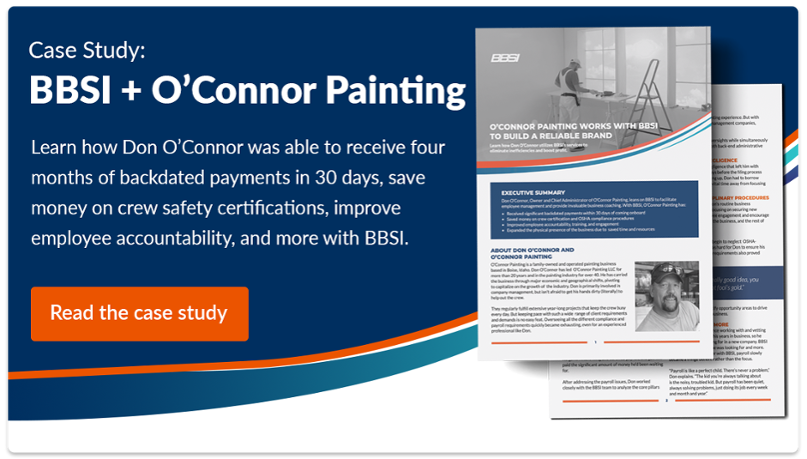
How to Create a Profit and Loss Statement
One of the best ways to keep a sharp eye on your financial health is a profit and loss (P&L) statement. At its essence, a profit and loss statement is a snapshot of your company’s financial health, providing a comprehensive overview of its performance by detailing revenue, costs, and expenses incurred during a specified period.
For companies operating in a razor-thin margin industry, a profit and loss statement doesn't just show dollars and cents — it can reveal operational inefficiencies, labor costs, and potential avenues for growth or improvement. Put simply, it’s the fiscal roadmap you can use to guide your company’s future decisions.
In this article, we’ll break down the essential steps and insights you need to create a clear and effective profit and loss statement for your business.
Benefits of a Profit and Loss Statement
Also known as an income statement, a profit and loss statement records your company’s revenue and expenses during a given time period. It allows you to identify the company’s cash inflows and outflows. In most cases, it will be dissected into smaller recording periods via monthly or quarterly statements. Advantages include:
- Visibility over gains, losses, trends, and cost savings opportunities
- Measurement of your bottom line from different angles to understand how costs impact profitability
- Empowerment of leadership to make informed, data-driven decisions
- Identification of initiatives providing ROI and those that lose money
- Simpler tracking of patterns and changes in supply costs or vendor performance
From a high level, your profit and loss statement offers a valuable framework by which you can manage and adjust your business objectives and growth.
What Are the Key Components of a Profit and Loss Statement?
Understanding a profit and loss statement’s key components is essential for effective financial management and decision-making. To start, let’s outline the fundamental elements that make up a comprehensive profit and loss statement:
- Revenue: Often referred to as "sales," revenue represents the total income generated by selling your goods or services.
- Cost of Goods Sold (COGS): COGS are the direct costs incurred in producing or purchasing the goods you sell, including raw material costs, labor, equipment, and overhead. It's critical to monitor this to maintain healthy margins.
- Gross Profit: Gross profit is calculated by subtracting COGS from revenue. This tells you how much profit the company makes after deducting the costs associated with making and selling its products or providing its services, which is important for evaluating profitability within a specific operational area.
- Operating Expenses: There are two types of operating expenses: fixed and variable. Fixed expenses are costs that remain constant over time, such as office and equipment expenses or employee salaries. Variable expenses, on the other hand, fluctuate from month to month. These may include raw materials, production supplies, energy costs, or cyclical part-time labor costs.
- Operating Profits (EBIT): Earnings before interest and taxes highlight the profit earned by deducting overhead expenses, including depreciation and amortization, from your gross profit.
- Net Income: Your net income reflects the final profitability after all costs, such as taxes or interest on loans for heavy machinery, are deducted.
To create an accurate profit and loss statement for your business, you’ll also need to select a reporting period from which to pull the necessary financial data. This timeline gives context to all the above values.
Gathering Your Financial Data
Most of this information can be sourced from your company’s accounting software, cash flow statements, and any estimates for untracked sub-categories.
That’s why it's crucial to have these financial records organized, so if you haven’t implemented one already, consider exploring dedicated accounting software for both efficiency and accuracy. The right data tools will help you categorize revenue sources and expenses, which is vital where multiple income and cost centers often exist.
As you go about this, pay special attention to calculating the Cost of Goods Sold (COGS) and Operating Expenses, as these directly impact your profit margins.
Calculating Revenue
For most businesses, calculating revenue isn't a cut-and-dry tallying of sales; it's a nuanced process that can get complicated quickly, especially in long-term projects where you might need to account for additional complexities like variations and change orders.
Here, consistency in your revenue recognition methods is paramount for accurate financial reporting. You need to apply the same accounting principles and methods from one accounting period to the next, or else your data will effectively be meaningless. This congruity allows for more accurate tracking of financial performance and facilitates better decision-making based on historical data.
Calculating Gross Profit
Gross profit tells you what your business made after accounting for direct costs. It’s a percentage of the margin based on the overall volume of revenue. For this figure, start by subtracting COGS from your revenue.
This simple calculation reveals how efficiently you're producing goods or services, showing what's leftover to cover operational expenses and, ideally, turn a profit.
But don't stop with gross profit. By taking this figure and dividing it by revenue, then multiplying by 100, you can determine your gross profit margin. This percentage serves as a diagnostic tool, clarifying how much of each revenue dollar is actual profit, which is especially important for sectors where costs can rapidly escalate.
Keep in mind that increasing revenue is only beneficial if it doesn't proportionally increase your costs. Using gross profit and gross profit margins to find the optimal equilibrium between revenue and profitability enables you to plan for sustainable growth.
Operating Expenses
Operating expenses provide insight into your operational efficiency and overall business health. By analyzing these costs — both fixed and variable — you can better understand how resources are being allocated while spotlighting areas for cost reduction or optimization.
When it comes to accounting for these various expenses, be sure to keep expense accounts clearly named. A well-organized ledger makes tracking and analyzing these costs significantly easier. It streamlines your accounting processes and ensures you're not scratching your head come tax time — or worse, leaving money on the table.
Net Profit or Net Loss
Net profit — or loss — is the ultimate gauge of your business's health, accounting for all expenses, including tax and interest.
A consistently positive net profit solidifies stakeholder confidence and signals sustainable business operations. Conversely, net loss, especially if it’s a consistent annualized trend, requires immediate action.
This figure will likely fluctuate over time. By tracking these trends in net profit margin, you can assess whether your current business practices are working and start to develop a forecast for future profit based on revenue.
How to Use a Profit and Loss Statement for Business Assessment
As mentioned, an income statement is a diagnostic tool that enables you to take the pulse of your business while spotlighting both strengths and areas for improvement. And varying levels of profit — gross, operating, and net — can reveal different issues or opportunities.
For instance, a high gross profit but low net income could indicate excessive operating expenses, be they salaries, rent, or interest. Or, if operating profit is high but net income is comparatively low, you might be overpaying in taxes.
Without diving into these numbers, it’s much harder to gauge your company’s strength and chart the proper course forward.
What Happens if You Don’t Have a Profit and Loss Statement?
Publicly traded companies don't just file annual profit and loss statements with the SEC as a legal formality — it's a crucial tool for maintaining transparency and accountability to shareholders. But even if you’re not legally required to file a profit and loss statement, don't think you're off the hook.
When you forgo a profit and loss statement, you're operating partially blind. You will need a clearer view of the financial health of your business or a detailed account of your expenses. This obscurity could easily lead to overspending and poor capital allocation, putting your business on the fast track to financial struggle.
Beyond that, a profit and loss statement isn't just a financial snapshot. Done properly, it can be a glimpse into the future, enabling you to go beyond simple assessments of the current state of the business to forecast its financial future.
This forward-looking perspective is invaluable for setting strategic goals and creating a feasible roadmap for achieving them. Without a profit and loss statement, you're not only risking the health of your business today, you are stunting its growth potential.
How a PEO Can Help with Profit and Loss Statements
To make wise and timely business decisions, you need to have up-to-date and accurate financial statements. But what if you need more expertise or resources to keep everything in order?
That’s where a professional employer organization (PEO) like BBSI can assist, providing comprehensive human resources services to businesses, including payroll, benefits, tax administration, and regulatory compliance.
For financial statements like a profit and loss statement, partnering with a PEO opens up several key advantages, including:
- Clarity: A PEO provides an unbiased third-party perspective, enabling you to demystify your financial landscape with a clear and candid picture of your business's health.
- Human Capital Expenses: By breaking down labor costs into granular detail, you can glean insight into how human resources impact your bottom line. This might include your total labor costs, employer-related taxes, and employee-related insurance/benefit expenses.
- Strategic Game Planning: Utilizing a PEO's expertise, you can leverage your financial statements as a launch pad for your future financial roadmap.
- Staffing and Recruiting: PEOs specialize in helping you identify, hire, and retain top talent by understanding your specific needs and then recruiting the right candidates for the right jobs.
- Quarterly Business Blueprint: BBSI provides regular check-ins, typically on a quarterly basis, which allow for timely strategy adjustments and performance reviews.
When it comes to financial statement creation and analysis, BBSI has human resources consultants and payroll specialists who are constantly examining global, regional, and industry trends to discuss them with each of our clients. Our team of professionals can help you interpret your data to help provide a business roadmap to maximize profit.
Disclaimer: The contents of this white-paper/blog have been prepared for educational and information purposes only. Reference to any specific product, service, or company does not constitute or imply its endorsement, recommendation, or favoring by BBSI. This white-paper/blog may include links to external websites which are owned and operated by third parties with no affiliation to BBSI. BBSI does not endorse the content or operators of any linked websites, and does not guarantee the accuracy of information on external websites, nor is it responsible for reliance on such information. The content of this white-paper/blog does not provide legal advice or legal opinions on any specific matters. Transmission of this information is not intended to create, and receipt does not constitute, a lawyer-client relationship between BBSI, the author(s), or the publishers and you. You should not act or refrain from acting on any legal matter based on the content without seeking professional counsel.
